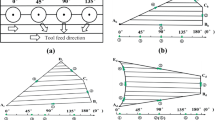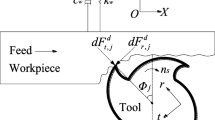Abstract
The poor rigidity of large composite material components in the helicopter has an important impact on robotic milling stability. Based on the machining stability of robotic edge trimming process, a method for calculating the component overhang is proposed in this paper. Firstly, the stability model of robotic longitudinal-torsional ultrasonic milling component (RCUM-LT) with poor rigidity is established by machining dynamics analysis. Then, the influence mechanism of variables such as ultrasonic vibration energy, workpiece overhang, and edge thickness on the stability region of robotic edge milling is explored emphatically. The calculation results show that the intake of ultrasonic energy suppresses robotic milling chatter effectively. As a result, the stability region of RCUM-LT is increased by 361.79%. In addition, the smaller the component overhang, the better the stability of edge milling will be. The effect of component thickness on RCUM-LT stability is the combined action result of modal property and dynamic milling force. Considering the influence of three variables on the stability region comprehensively, a reasonable boundary curve of the adsorption position is achieved according to RCUM-LT stability model. It provides technical support for realizing robotic edge milling composite material with high efficiency and stability. Finally, the verification experiments are carried out for stability lobes and optimal overhang length. The results show that the experimental results of RCUM-LT stability are in good agreement with the theoretical prediction. With the adsorption method proposed by this study, the surface roughness and its consistency of machined surface are significantly improved.













Similar content being viewed by others
Data availability
All data generated or analyzed during this study are included in this published article.
Code availability
Not applicable.
References
Geng DX, Zhang DY, Xu YG, He FT, Liu DP, Duan ZH (2015) Rotary ultrasonic elliptical machining for side milling of CFRP: tool performance and surface integrity. Ultrasonics 59:128–137
Duboust N, Pinna C, Ghadbeigi H, Ayvar-Soberanis S, Phadnis VA, Collis A, Kerrigan K (2017) 2D and 3D finite element models for the edge trimming of CFRP. Procedia CIRP 58:233–238
Nguyen D, Abdullah MS, Khawarizmi R, Kim D, Kwon P (2020) The effect of fiber orientation on tool wear in edge-trimming of carbon fiber reinforced plastics (CFRP) laminates. Wear 450:203–213
Slamani M, Chatelain JF (2020) Kriging versus Bezier and regression methods for modeling and prediction of cutting force and surface roughness during high speed edge trimming of carbon fiber reinforced polymers. Measurement 152:107370
Wang FJ, Zhang BY, Jia ZY, Zhao X, Wang Q (2019) Structural optimization method of multitooth cutter for surface damages suppression in edge trimming of carbon fiber reinforced plastics. J Manuf Process 46:204–213
Ye CC, Yang JX, Zhao H, Ding H (2021) Task-dependent workpiece placement optimization for minimizing contour errors induced by the low posture-dependent stiffness of robotic milling. Int J Mech Sci 205:106601
Slamani M, Gauthier S, Chatelain JF (2016) Comparison of surface roughness quality obtained by high speed CNC trimming and high speed robotic trimming for CFRP laminate. Robot Cim-Int Manuf 4:63–72
Zhu ZR, Tang XW, Chen C, Peng FY, Yan Y, Zhou L, Li ZP, Wu JW (2021) High precision and efficiency robotic milling of complex parts: challenges, approaches and trends. Chin J Aeronaut 35(2):22–46
Tao JF, Qin CJ, Xiao DY, Shi HT, Liu CL (2019) A pre-generated matrix-based method for real-time robotic drilling chatter monitoring. Chin J Aeronaut 31(12):2755–2764
Nguyen V, Johnson J, Melkote S (2020) Active vibration suppression in robotic milling using optimal control. Int J Mach Tool Manu 152:103541
Wang G, Li WL, Jiang C, Ding H (2022) Machining allowance calculation for robotic edge milling an aircraft skin considering the deformation of assembly process. IEEE-ASME T Mech. https://doi.org/10.1109/TMECH.2021.3131309
Chen C, Peng FY, Yan R, Fan Z, Li Y, Wei DQ (2018) Posture-dependent stability prediction of a milling industrial robot based on inverse distance weighted method. Procedia Manuf 17:993–1000
Zhang JL, Liao WH, Zhao W, Tian W, Zheng K, Li B (2022) Research on stability of robotic longitudinal-torsional ultrasonic milling with variable cutting force coefficient. Int J Adv Manuf Technol 121:1707–1715
Xin SH, Peng FY, Tang XW, Yan R, Li ZP, Wu JW (2022) Research on the influence of robot structural mode on regenerative chatter in milling and analysis of stability boundary improvement domain. Int J Mach Tool Manu 179:103918
Ji YJ, Wang LY, Song Y, Wang HJ, Liu ZB (2022) Investigation of robotic milling chatter stability prediction under different cutter orientations by an updated full-discretization method. J Sound Vib 536:117150
Pan ZX, Zhang H, Zhu ZQ, Wang JJ (2006) Chatter analysis of robotic machining process. J Mater Process Tech 173:301–309
Cordes M, Hintze W, Altintas Y (2019) Chatter stability in robotic milling. Robot Cim-Int Manuf 55:11–18
Cen LJ, Melkote SN, Castle J, Appelman H (2018) A method for mode coupling chatter detection and suppression in robotic milling. J Manuf Sci E-T Asme 140(8):081015
Wang Y, Zhang MK, Tang XW, Peng FY, Yan R (2022) A kMap optimized VMD-SVM model for milling chatter detection with an industrial robot. J Intell Manuf 33(5):1483–1502
Chen F, Zhao H (2018) Design of eddy current dampers for vibration suppression in robotic milling. Adv Mech Eng 10(11):1–15
Yuan L, Sun SS, Pan ZX, Ding DH, Gienke O, Li WH (2019) Mode coupling chatter suppression for robotic machining using semi-active magnetorheological elastomers absorber. Mech Syst Signal Process 117:221–237
Gao J, Altintas Y (2020) Chatter stability of synchronized elliptical vibration assisted milling. CIRP J Manuf Sci Technol 28:76–86
Sun LJ, Zheng K, Liao WH (2022) Chatter suppression and stability analysis of rotary ultrasonic milling titanium alloy thin-walled workpiece. Int J Adv Manuf Technol 118:2193–2204
Yang ZC, Zhu LD, Zhang GX, Ni CB, Lin B (2020) Review of ultrasonic vibration-assisted machining in advanced materials. Int J Mach Tool Manu 156:103594
Wan SK, Jin XL, Maroju NK, Hong J (2019) Effect of vibration assistance on chatter stability in milling. Int J Mach Tool Manu 28:76–86
Qin SQ, Zhu LD, Wiercigroch M, Ren TY, Hao YP, Ning JS, Zhao JZ (2022) Material removal and surface generation in longitudinal-torsional ultrasonic assisted milling. Int J Mech Sci 227:107375
Dong S, Zheng K, Liao WH (2018) Stability of lateral vibration in robotic rotary ultrasonic drilling. Int J Mech Sci 145:346–352
Dong S, Liao WH, Zheng K, Liu JS, Feng JD (2019) Investigation on exit burr in robotic rotary ultrasonic drilling of CFRP/aluminum stacks. Int J Mech Sci 151:868–876
Sun LJ, Zheng K, Liao WH, Liu JS, Feng JD, Dong S (2020) Investigation on chatter stability of robotic rotary ultrasonic milling. Robot Cim-Int Manuf 63:101911
Sun LJ, Liao WH, Zheng K, Tian W, Liu JS, Feng JD (2022) Stability analysis of robotic longitudinal-torsional composite ultrasonic milling. Chin J Aeronaut 35(8):249–264
He FX, Liu Y, Liu K (2019) A chatter-free path optimization algorithm based on stiffness orientation method for robotic milling. Int J Adv Manuf Technol 101(9–12):2739–2750
Faassen RPH, Wouw NVD, Oosterling JAJ, Nijmeijer H (2003) Prediction of regenerative chatter by modelling and analysis of high-speed milling. Int J Mach Tool Manu 43(14):1437–1446
Zhao X, Zheng LY, Liu XY, Cao YS (2020) Chatter stability prediction for multi-robots collaborative milling system. Procedia CIRP 93:856–861
Jiang SL, Sun YW (2018) A multi-order method for predicting stability of a multi-delay milling system considering helix angle and run-out effects. Chin J Aeronaut 131(6):1375–1387
Ding Y, Zhu LM, Zhang XJ, et al (2010) Second-order full-discretization method for milling stability prediction. Int J Mach Tool Manu 50(10):926–932
Acknowledgements
The authors would like to acknowledge Wei Tian from Nanjing University of Aeronautics and Astronautics for providing us with the robotic milling platform.
Funding
This work was supported by the National Natural Science Foundation of China (Grant No. 52075265).
Author information
Authors and Affiliations
Contributions
Conceptualization: Kan Zheng, Wenhe Liao; theoretical analysis: Dan Meng; data analysis: Dan Meng, Hongwei Sun; manuscript writing: Dan Meng, Weiwei Xiong, Lianjun Sun; constructive discussions: Dan Meng, Kan Zheng. All the authors have read and agreed to the published version of the manuscript.
Corresponding author
Ethics declarations
Ethics approval
Not applicable.
Consent to participate
Not applicable.
Consent for publication
Not applicable.
Competing interests
The authors declare no competing interests.
Additional information
Publisher's note
Springer Nature remains neutral with regard to jurisdictional claims in published maps and institutional affiliations.
Rights and permissions
Springer Nature or its licensor (e.g. a society or other partner) holds exclusive rights to this article under a publishing agreement with the author(s) or other rightsholder(s); author self-archiving of the accepted manuscript version of this article is solely governed by the terms of such publishing agreement and applicable law.
About this article
Cite this article
Meng, D., Sun, H., Xiong, W. et al. Investigation on stability of robotic rotary ultrasonic edge milling component with poor rigidity. Int J Adv Manuf Technol 124, 1579–1590 (2023). https://doi.org/10.1007/s00170-022-10498-4
Received:
Accepted:
Published:
Issue Date:
DOI: https://doi.org/10.1007/s00170-022-10498-4




